| The
Graeco-Roman cities The Decapolis, meaning ten cities in Greek, consisted of ten Graeco-Roman cities in the land of northern Jordan, Syria and Palestine. One of these cities is Pella, a short drive north of Amman in the Jordan Valley. It is among the largest and most important archaeological sites in the region. Most of the visible structures date from the Roman, Byzantine and Islamic periods (2nd to 14th centuries A.D) and there is ample evidence of human occupation during the earlier Hellenistic, Persian, Iron, Bronze, Chacolithic, Neolithic and Paleolithic periods. |
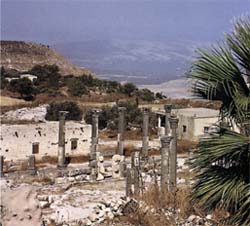 Umm Qais |
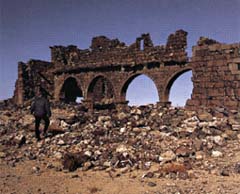 The West Church at Umm el Jimal |
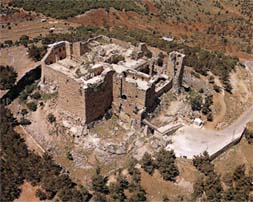 Aerial view of Ajlun Castel |
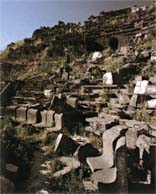 Theater at Umm Qais |
Of comparable importance among the Decapolis sites is Umm Qais, known in antiquity as Gadara, where the ottoman Governorís house has been restored and opened as a museum. Gadara commands magnificent views over the northern Jordan Valley, the Sea of Galilee (Lake Tiberias), the Yarmouk River gorge and the Golan heights. On a clear day the snow peak of Mount Hermon is visible. |
|
To the northeast of Gadara lies ancient Abila, more rural than
Jerash and Umm Qais, where Roman Roman temples, Byzantine churches
and early mosques lie amidst olive groves and wheat fields.
Excavations indicate that the site was inhabited 5,000 years ago in
the Early Bronze Age, and appears to have been continually used by
man since then. Contrasting sharply with the splendors of Jerash and
the other cities of the Decapolis is Umm el Jimal. On the edge of the the stark, black basalt region of north east Jordan, Umm el Jimal is one of the areaís most impressive and eerie monuments of ancient |
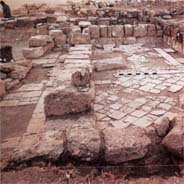 Abila, the ancient city |
It was built in 1184 by Izzedine Ussama, one of the generals of the Arab leader Salah ed Din (Saladin). Nearer to Amman is Iraq el Amir, an antiquity site dating back to the 2nd Century B.C, where the visitor finds a carefully restored Hellenistic villa.
(AMMAN - JERASH - JORDAN - PETRA - WADI RUM - AQABA - THE DEAD SEA - MUJIB WILDLIFE RESERVE - DANA NATURE RESERVE - SHAUMARI NATURE RESERVE - AJLOUN NATURE RESERVE - AZRAQ WETLAND RESERVE - BIRD WATCHING - THE GULF OF AQABA - BETHANY BEYOND JORDAN)
EGYPT - LEBANON - SYRIA